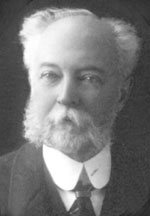News for Winter 2002
Architectural Attraction
 |
Around 8.30am on Sunday 17 November the ambitious plans of Professor Terry Bennett to celebrate the life and work of the flamboyant Nottingham architect Watson Fothergill visually came nearer fruition.
About that time, dictated by the need to restrict traffic on George Street, a giant crane hoisted a 12ft replica metal finial onto the top of the spire on the architect’s former offices at 15 George Street. The original finial, now disfigured by corrosion, was of cast iron. Its replacement is of welded steel, created over a period of four weeks by local craftsmen guided by original drawings and old photographs.
University of Nottingham Professors Terry Bennett and Sheila Gardiner have privately purchased and are fully restoring 15-17 George Street. They intend to display in the architect’s upstairs offices not only his achievements, but also the work of his architectural contemporaries in Nottingham, and later regionally and nationally.
If weather permits the completion of the external work - three attempts were needed to fit the finial on its rain-swollen base - the building itself should be ready this month. Fitting out with exhibition material could be achieved by next summer.
Ken Brand
Nottinghamshire articles
Members’ attention is drawn to the Georgian Group’s Journal, vol XI (2001) which includes a number of contributions on Nottinghamshire. Giles Worsley has written a short piece on ‘Sir Robert Clifton’s Belvedere’ at Clifton, which includes hitherto unpublished photographs ‘showing the structure largely intact in the 1950s, and then roofless and derelict less than twenty years later. It was demolished about 1969. Peter Smith, of English Heritage, contributes a superb article on ‘Lady Oxford’s Alterations at Welbeck Abbey, 1741-55’, which, although described modestly by the author as a ‘first attempt’, actually adds significantly to our understanding of the architectural history of Welbeck. If you don’t have easy access to the journal ask your local library to acquire a copy.
Neville Hoskins
How different it was 130 years ago... |
|
At a meeting earlier this year of the Amenity Societies Group and members of Nottingham City Council Leisure & Community Services held at Lenton Grove, the radical changes to Nottingham’s museums envisaged under the Forward Plan for the Museums Service ensured a lively discussion. Wollaton Hall’s future was the main topic for consideration, within which the virtual closure of the industrial museum and cramming the natural history collection into the stable block, already earmarked for upgraded catering facilities, became the biggest issues. How different it was 130 years ago... On 19 January 1872 Sir Henry Cole, KCB, Director of the South Kensington Museum, wrote to the Mayor of Nottingham, in which he proposed the establishment in Nottingham of a Museum connected with that at South Kensington. The main reason for choosing Nottingham above all other provincial towns and cities was the prime position nationally that the Nottingham School of Art had attained under the leadership of its principal J S Rawle. |
In fact he noted this feat in his letter when he warmly urged the town to adopt further measures for maintaining the high position, which the School of Art had attained, and ‘extending the influence and advantages of further art education by the establishment of a Museum of Science and Art, especially illustrative of those industries which have given to Nottingham the eminent position it holds among the great manufacturing centres of the United Kingdom’. For such a Museum he foresaw and predicted a great career of usefulness. ‘Nottingham’, he noted, ‘is distinguished for possessing Public Gardens, a Natural History Museum, and a Public Library.’ The Town Council, led enthusiastically by the Mayor, W.G. Ward, took up Cole’s challenge at their next meeting and set in motion a chain of events which culminated in the acquisition, conversion and opening of Nottingham Castle as the country’s first provincial museum of art. Ken Brand (with a little help from T.C. Hine) |